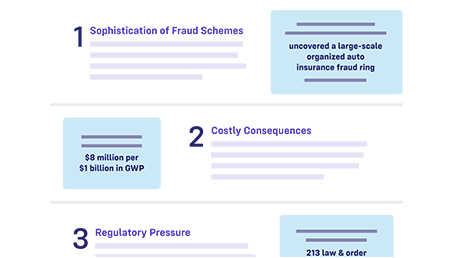Dan Donovan is Shift's VP Customer Success & Solution Consulting, Americas
In the fast-paced world of insurance, combating fraud remains an ever-evolving challenge. As insurers tackle this issue, they face a critical decision: should they develop an in-house fraud detection system, or opt for a pre-built solution from a trusted vendor?
When evaluating solutions for fraud detection, insurers consider total cost of ownership (TCO), resource allocation, ease of integration, and long term strategy; fold AI into the mix, and these considerations become even more substantial. These criteria serve as the critical lens through which insurers estimate the cost to build, integrate, train on, and maintain a viable solution.
Within each of these categories lie commonly thought of considerations, but also an abundance of often overlooked considerations.
The Cost to Build and Maintain an AI Fraud Detection Solution
Building an in-house system may seem appealing and straightforward for insurers. It affords the opportunity for significant customization of the final solution. All it takes are the allocated technical resources and a plan to scope, train and implement. Or so it goes. The reality is that Insurer IT teams are valuable resources, so the time and effort to build an effective system competes with other critical projects. Winning the resources once is a real feat, but unexpected new priorities can arise that reallocate shared services of an organization. That means delayed implementation timelines, sacrificed features, and higher total cost of ownership, as the benefit moves further and further out.
Moreover, the maintenance of the built system becomes a challenge. An initial plan may imagine reduced resourcing for maintenance once built. Yet, the reality of fraud detection is that fraud trends and investigation require continuous adaptation. This can lead to degraded performance over time without resourced improvement and enhancements. Comparatively, a vendor offers the advantage of dedicated IT and data science resources that continuously improve the product, ensuring it stays up-to-date with the latest fraud trends and innovations.
Aligning Build Expectations and Realities
The technology under the hood of fraud detection solutions continues to grow in sophistication by learning and further developing from its outputs; this results in continuously increasing value to an organization. With AI-specialized vendors focusing solely on improving their performance and outputs for insurers, it is important to have an understanding of the capabilities and limitations of internal teams on what can truly be built and maintained in-house.
Vendors can take the technical and data science lift off of the shoulders of insurers - building and managing powerful, insurance-trained AI models to capture evolving fraud schemes and accelerate investigations.
Integrations
Integrating a fraud detection solution into insurer core systems is a must, whether built in-house or through a vendor. And IT teams now typically have standard software integration approaches that make this step seem easy. Yet, the rubber meets the road when it comes to the next set of integrations, namely internal and external datasets that play a critical role in fraud detection. With each integration comes testing, formatting, cleaning, de-noising, and unifying with claims data, followed by new detection techniques and models. Vendor solutions are able to integrate external data sets into detection models, proven to enhance detection accuracy and efficiency
Beyond data integrations, partnering with a vendor provides the opportunity to gain insights and knowledge from their experiences across multiple insurers and markets, in a sense, integrating the learnings of the market. Vendors can provide a broader perspective on fraud trends, detection techniques, and the most relevant data sources, while offering valuable guidance to their clients. Working with a solution in house locks away these learnings leaving insurers at a critical disadvantage.
Aligning Integration Expectations and Realities
Vendors are regularly researching, testing, preparing, and integrating external data sets, while also building standard integrations with core systems. Without planned resourcing for data and system integrations, in-house fraud detection solutions will be at a disadvantage to fraudsters.
Training and Onboarding
The implications of the build vs buy decision don’t just stop with the technology evaluation. When implementing fraud detection solutions, it is critical to effectively train and enable teams in order to set them up for success. With AI solutions in particular, this means more than just a quick tutorial or walkthrough. For internally created solutions, this could mean pulling in additional shared resources for training, or leaving the training responsibilities in the wrong hands.
With a true vendor partnership, technology and insurance subject matter experts are there to build product champions, support a smooth implementation and onboarding process, as well as provide continuous AI-driven insights based on platform findings, industry trends or learnings derived from past customer experience. Having dedicated and ongoing Customer Success support can make the difference in effectively operationalizing the technology and fully realizing the value of the solution.
Conclusion
It is clear that the decision to build or buy a fraud detection system is a crucial one for insurance carriers. When making this decision there are essential factors to consider, such as total cost of ownership, opportunity cost, fear of change, efficiency gains, and the advantages of shared insights. By carefully evaluating these factors and aligning them with their specific needs, insurance carriers can make an informed decision that maximizes their fraud detection capabilities while optimizing resources and maintaining a competitive edge for their customers.
Want to learn about change management for advanced AI solutions? Stay tuned for our upcoming blog where Dan Donavan discusses the implications of taking on a new solution and how it impacts your teams.


